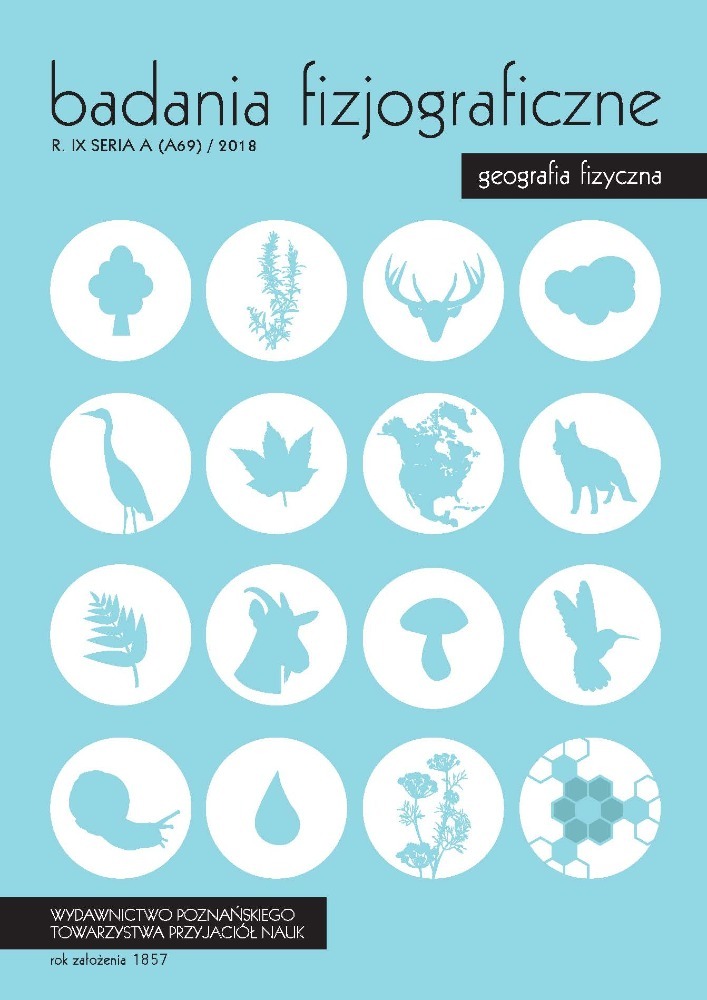Abstrakt
The article presents examples of synoptic situations when the permissible concentration of PM10 was severely exceeded in 2010–2017 in Poznań. In many Polish cities, there are deviations from the norms for a number of days during the year. The scale of concentration of PM10 in the air is largely affected by the prevailing meteorological conditions such as low temperature and low wind speed. First, periods of the highest daily concentrations of pollutants were selected. Subsequently, synoptic maps for selected days were analysed. The most common cause of the pollution was a large boom which brought Arctic air to Poland. In this case, the highest concentration was accompanied by very low air temperatures and the resulting more intensive heating of buildings.
Bibliografia
Bokwa A., 2012, Zanieczyszczenie powietrza pyłem zawieszonym PM10 a sytuacje synoptyczne i warunki termiczne w Krakowie, [w:] Z. Bielec-Bąkowska, E. Łupikasza, A. Widawski (red.), Rola cyrkulacji atmosfery w kształtowaniu klimatu, Katedra Klimatologii, WNZ UŚ, Sosnowiec, 275–286.
Caputa Z.A., Lesniok M.R., Niedzwiedz T., Bil-Knozova G., 2009: The influence of atmospheric circulation and cloudiness on the intensity of temperature inversions in Sosnowiec (Upper Silesia, Southern Poland), Internat. Journ. of Environ. and Waste Management, 4(1–2), 17–31.
Cembrzyńska J., Krakowiak E., Brewczyński P.Z., 2012: Zanieczyszczenie powietrza pyłem zawieszonym PM10 oraz PM2, 5 w warunkach silnej antropopresji na przykładzie miasta Sosnowiec, Med. Środ.-Environ. Med., 15(4), 31–38.
Czarnecka M., Kalbarczyk R., Kalbarczyk E., 2007: Variability in particulate matter concentrations versus precipitation in Pomerania region, Pol. Journ. Natur. Sc., 22(4), 645–659.
Czarnecka M., Nidzgorska-Lencewicz J., 2015: Application of cluster analysis in defining the meteorological conditions shaping the variability of PM10 concentration, Roczn. Ochr. Środ., 17(1).
Czernecki B., Półrolniczak M., Kolendowicz L., Marosz M., Kendzierski S., Pilguj N., 2016: Influence of the atmospheric conditions on PM10 concentrations in Poznań, Poland, Journ. of Atm Chem., 74(1), 115–139.
Drzeniecka A., Pereyma J., Pyka J.L., Szczurek A., 2000: Wpływ warunków meteorologicznych na stężenie zanieczyszczeń powietrza w Śródmieściu Wrocławia, Chem. i Inż. Ekol., 7(8–9), 865–882.
Godłowska J., Tomaszewska A.M., 2010: Relations between circulation and winter air pollution in Polish urban areas, Arch. of Environ. Protection, 36(4), 55–66.
Jędruszkiewicz J., Czernecki B., Marosz M., 2017: The variability of PM10 and PM2. 5 concentrations in selected Polish agglomerations: the role of meteorological conditions, 2006–2016, Internat. Journ. of Environ. Health Res., 27(6), 441–462.
Jędruszkiewicz J., Piotrowski P., Pietras B., 2016: Koncentracja zanieczyszczeń pyłowych powietrza PM2, 5 w Krakowie w latach 2010–2014, Act. Geograph. Lodziensia, 104, 123–135.
Leśniok M.R., Caputa Z.A., 2009: The role of atmospheric circulation in air pollution distribution in Katowice Region (Southern Poland), Internat. Journ. of Environ. and Waste Management, 4(1), 2.
Leśniok M., Małarzewski Ł., Niedźwiedź T., 2010: Classification of circulation types for Southern Poland with an application to air pollution concentration in Upper Silesi, Phys. and Chem. of the Earth, Pts A/B/C, 35(9–12), 516–522.
Lewandowska A.U., Falkowska L.M., 2013: High concentration episodes of PM10 in the air over the urbanized coastal zone of the Baltic Sea (Gdynia–Poland), Atm Res., 120, 55–67.
Majewski G., 2005: Zanieczyszczenie powietrza pyłem zawieszonym PM10 na Ursynowie i jego związek z warunkami meteorologicznymi, Prz. Nauk., Ser. Inż. Kształt. Środ., 1(31), 210–223.
Pietruczuk A., Jarosławski J., 2013: Analysis of particulate matter concentrations in Mazovia region, central Poland, based on 2007–2010 data, Act. Geoph., 61(2), 445–462.
Pilguj N., Kendzierski S., Kolendowicz L., 2018: Rola typów cyrkulacji atmosferycznej w kształtowaniu stężeń pyłu zawieszonego PM10 w Poznaniu, Przegl. Geogr., 90(1), 77–91.
Radomski J., 2008: Wpływ typów cyrkulacji na stężenie pyłu zawieszonego (PM10) w zimie na Wyżynie Śląskiej, Probl. Ekol., 12, 207–210.
Rawicki K., 2014: Variability of particulate matter concentrations in Poland in the winter 2012/2013, Fol. Pomeranae Universitatis Technologiae Stetinensis. Agr., Alimentaria, Piscaria et Zootechnica, 31.
Skrzypski J., 1999: Rola cyrkulacji atmosferycznej w kształtowaniu stopnia czystości powietrza napływającego nad aglomeracje miejsko-przemysłowe (na przykładzie Łodzi), Act. Univ. Lodziensis Fol. Geogr. Phys., 3, 1998.
Licencja
Prawa autorskie (c) 2018 SEBASTIAN KENDZIERSKI, HANNA FORYCKA-ŁAWNICZAK

Utwór dostępny jest na licencji Creative Commons Uznanie autorstwa – Użycie niekomercyjne – Bez utworów zależnych 4.0 Międzynarodowe.
PTPN ma prawa autorskie do tytułu czasopisma
 https://creativecommons.org/licenses/by-nc-nd/4.0/
https://creativecommons.org/licenses/by-nc-nd/4.0/
